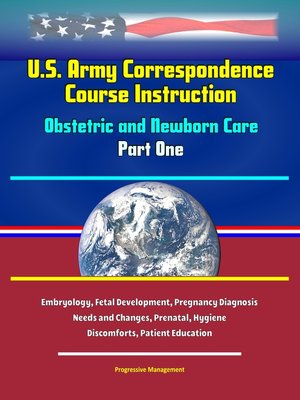U.S. Army Correspondence Course Instruction
ebook ∣ Obstetric and Newborn Care--Part One--Embryology, Fetal Development, Pregnancy Diagnosis, Needs and Changes, Prenatal, Hygiene, Discomforts, Patient Education
By Progressive Management

Sign up to save your library
With an OverDrive account, you can save your favorite libraries for at-a-glance information about availability. Find out more about OverDrive accounts.
Find this title in Libby, the library reading app by OverDrive.



Search for a digital library with this title
Title found at these libraries:
| Library Name | Distance |
|---|---|
| Loading... |
Professionally converted for accurate flowing-text e-book format reproduction, this is a reproduction of a U.S. Army Correspondence Course Instruction: Obstetric and Newborn Care - Part One.
Contents: Introduction * Lesson 1 - Reproductive Anatomy and Physiology * Lesson 2 - Embryology and Fetal Development * Lesson 3 - Diagnosis of Pregnancy * Lesson 4 - Psychologic Needs During Pregnancy * Lesson 5 - Physiologic Changes During Pregnancy * Lesson 6 - Prenatal Care During Pregnancy * Lesson 7 - Personal Hygiene and Care During Pregnancy * Lesson 8 - Minor Discomforts Of Pregnancy * Lesson 9 - Patient Education During Pregnancy * Lesson 10 - Fetal Positions and Adaptations * Glossary
Obstetrics is the branch of medicine concerned with the management of childbirth. The ultimate goal of all workers in the field of obstetrics is to assist a mother to produce a healthy baby, with a minimum of danger and discomfort to both. Pregnancy is defined as the condition of being "with child." To understand pregnancy, we must know how it begins, how the fetus grows in the uterus, and how it affects the mother. Today, more than ever before nurses play a central role in the planning for and the experience of birth, and in how families feel about the experience afterwards. You, as a practical nurse, should be knowledgeable of all aspects of maternal nursing. And, by applying this knowledge you will develop skills and experience in providing quality nursing care.
The organs of the reproductive systems are concerned with the general process of reproduction, and each is adapted for specialized tasks. These organs are unique in that their functions are not necessary for the survival of each individual. Instead, their functions are vital to the continuation of the human species. In providing maternity gynecologic health care to women, you will find that it is vital to your career as a practical nurse and to the patient that you will require a greater depth and breadth of knowledge of the female anatomy and physiology than usual. The female reproductive system consists of internal organs and external organs. The internal organs are located in the pelvic cavity and are supported by the pelvic floor. The external organs are located from the lower margin of the pubis to the perineum. The appearance of the external genitals varies greatly from woman to woman, since age, heredity, race, and the number of children a woman has borne determine the size, shape, and color.







